|
|
| |
SPAIN
USEFUL INFORMATION

Spain is a beautiful and diverse country located in the southwest of Europe. Spain's geographic position and it's moderate winters and hot summers means it attracts tourits all year round. There are many sandy beaches and famous resorts suitable for summer vacations. As well as boading a warm client Spain has become one of the richest cultural heritages in Europe with the most World Heritage sites designated by UNESCO along with Italy, each with 42 sites. It is no wonder that in 2007, Spain became the second most visited country in the world after France.
Location:
Southwestern Europe, bordering the Mediterranean Sea, North Atlantic Ocean, Bay of Biscay, and Pyrenees Mountains; southwest of France.
Area:
505,370 sq km
Capital:
Madrid
Neighbouring countries:
Andorra 63.7 km, France 623 km, Gibraltar 1.2 km, Portugal 1,214 km, Morocco (Ceuta) 6.3 km, Morocco (Melilla) 9.6 km
Coastline:
4,964 km
Climate:
temperate; clear, hot summers in interior, more moderate and cloudy along the coast; cloudy, cold winters in interior, partly cloudy and cool along the coast
Elevation extremes:
lowest point: Atlantic Ocean 0 m
highest point: Pico de Teide (Tenerife) on Canary Islands 3,718 m
Population:
46,754,784 (July 2011 est.)
Ethnic groups:
composite of Mediterranean and Nordic types.
Religions:
Roman Catholic 94%, other 6%
Languages:
Castilian Spanish (official) 74%, Catalan 17%, Galician 7%, and Basque 2% (official regionally)
Time difference: UTC+1 (6 hours ahead of Washington, DC during Standard Time), daylight saving time +1hr begins last Sunday in March; ends last Sunday in October
Getting to Spain:
Spain's national airline is Iberia (or Iberia Airlines), but the country can also be flown into on many international passenger airlines such as Spanair, Air Europa, Vueling, Air Berlin, Clickair and charter airlines, both of which fly to many tourist spots in the region. A great number of major international airlines operate direct flights to various destinations in Spain from the USA, Canada, Australia and Europe. Owing to the number of flights available, ticket prices vary greatly and there is a wide range of discount fares and special tickets available.
The main train operator in Spain is RENFE; the AVE (Spanish high speed train) or Talgo are the intercity services for tourists. Spanish transit is marked by a high degree of integration between its long distance railway system and inner-city metro systems. Spain is currently working to develop a high-speed rail between Madrid and Lisbon. There are already high speed services between Madrid and Seville, from Madrid to Lleida and extended to Barcelona, Madrid to Valladolid and from Córdoba to Málaga.
Spain possesses a highly developed highway system. Highways and good roads reach Madrid very well as well as large cities. However it can be more difficult to reach less popular cities or villages which may not have such good communications. Renting a car in Spain can be expensive. It is much cheaper to rent a car from an agency before leaving home. Check with your credit card company before investing in insurance through your rental agency. Most credit card companies cover this when the rental is purchased with the card. In order to rent a car in Spain, the driver must be over 21 and have had a valid driver's license for over a year. Many rental firms insist on an international driver's license for citizens of non EU countries.
Transportation by bus is also popular. Coaches will reach places that trains do not go and offer more schedules and destinations. There are many different coach companies working in Spain that offer a variety of rates and so we recommend you plan your trip in advance.
Passports and visas:
PASSPORTS: Passport valid for at least three months including 90 days beyond the planned stay required by all except nationals of the EU holding valid national ID cards for stays of up to 90 days.
VISAS: Required by all except the following for stays of up to 90 days:
(a) nationals of EU countries, Norway, Iceland and Switzerland regardless of purpose and/or length of stay.
(b)nationals of Andorra, Anguilla, Argentina, Bermuda, Bolivia, Brazil, British Virgin Islands, Brunei, Bulgaria, Cayman Islands, Chile, Costa Rica, El Salvador, Falkland Islands, Guatemala, Honduras, Hong Kong (SAR), Israel, Korea (Rep), Liechtenstein, Macau (SAR), Malaysia, Mexico, Monaco, Montserrat, New Zealand, Nicaragua, Panama, Paraguay, Romania, St Helena, San Marino, Singapore, Turks & Caicos Islands, Uruguay, Vatican City and Venezuela;
(c) transit passengers continuing their journey by the same or first connecting aircraft provided holding valid onward or return documentation and not leaving the airport (except nationals of Afghanistan*, Angola, Bangladesh*, Congo (Dem Rep)*, Cote d’Ivoire, Cuba, Eritrea*, Ethiopia*, Ghana*, Guinea-Bissau, Haiti, India, Iran*, Iraq*, Liberia, Mali, Nigeria*, Pakistan*, Senegal, Sierra Leone, Somalia*, Sri Lanka*, Syrian Arab Republic and Togo who always require an airport transit visa if not a permanent resident of Canada, EU countries or the USA; nationals marked * must be permanent residents of Andorra, Canada, Japan, Monaco, San Marino, Switzerland or the USA).
(d) nationals of any of the Schengen member states who hold permanent residency are entitled to re-enter the Schengen area without a visa, provided proof of residence and a valid passport are submitted.
(e) crew members of airlines and merchant navy for stays of up to 90 days.
As the above list may change at short notice, visitors are advised to check transit regulations with the relevant Consulate or Embassy before travelling.
Customs regulations:
If you are bringing in more than € 6,010.12, you must declare so. At present, anyone older than 18 years of age may carry a maximum of 200 cigarettes, 100 small cigars, 50 cigars, or 250 g of cut tobacco. As for alcohol, you are allowed to bring up to one litre of spirits (alcoholic content 22º), and two litres if alcoholic content is less than 22º. Fragrances are limited to 50 g of perfume, and 250 ml of eau de toilette.
According to the European Commission, travellers may not bring any animal food products into Spain, neither for their own consumption, nor as part or their luggage (including meat, meat products, milk, and dairy products). The only exception is baby powdered milk, sealed in its original package. Any other foods may be brought into Spain, up to a maximum weight of one kilogram.
Health and safety:
Tourists requiring urgent medical care should go to the nearest hospital emergency room (airports and many train stations also have medical teams and first aid facilities). Those with serious illnesses or allergies should always carry a special note from their physicians certifying in detail the treatments in progress or that may be necessary.
Electricity:
The standard electric current in Spain is 220 volts but it is common in older places to find the old 115 volt supply. Both systems use plugs with two round pins. Travel adaptors can be purchased to convert plugs from other countries. Many appliances in Spain are not earthed and it is common to find electric sockets in bathrooms, near water supplies so extreme care should be exercised. You might find that 240V appliances work slowly. Such as kettles taking longer to heat. This is because they are designed to work at an optimum voltage of 240v whereas in Spain the voltage can vary. Sometimes it can be as low as 200V.
Emergency numbers in Spain:
112 is the general emergency telephone number in Spain
061 is for the Ambulancia (ambulance)
062 is for the Guardia Civil (Civil Guard)
080 is for the Bomberos (fire services)
091 is for the Policia Nacional (National Police)
Currency:
Euro
Credit cards
Travellers cheques, cheques and foreign money can be changed at banks, railway stations and airports, and very often at main hotels (generally at a less convenient rate). Check with banks for details and current rates.
Credit & debit cards: MasterCard, Diners Club and Visa are widely accepted, as well as Eurocheque cards. Check with your credit or debit card company for merchant acceptability and other facilities which may be available.
Travellers cheques: Travellers cheques are accepted almost everywhere. To avoid additional exchange rate charges, travellers are advised to take travellers cheques in Euros, Pounds Sterling or US Dollars.
Summer Resorts and Beaches:
Spain's mild climate during the whole year and the extensive sandy beaches of the Mediterranean and Atlantic Ocean makes it ideal for summer vacations. The Spanish coasts suitable for summer vacations include the Costa Brava, the Costa Daurada and the Costa del Maresme located in Catalonia. Famous resorts include Salou and the city of Barcelona that has the largest harbour in Spain. One of the most developed coastal areas of Spain includes the Costa del Azahar, Costa de Valencia, whose capital city is Valencia and the Costa Blanca. To the south there is the Costa de Almería, the Costa Tropical, the Costa del Sol and the Costa de la Luz, all in Andalucía. Some of its summer towns are famous worldwide, like Marbella in Málaga Province. Spain also has two archipelagoes, the volcanic Canary Islands, in the Atlantic, and the Balearic Islands, in the Mediterranean both of which are very popular. Beaches in the north are notably colder than the Mediterranean's.
Fixed public holidays:
1st Jan New Year's Day
6th Jan Epiphany
19th Mar San Jose
21st April Maundy Thursday
22nd April Good Friday
1st May Labour Day
12th Oct National Day
1st Nov All Saints' Day
6th Dec Constitution Day
8th Dev Immaculate Conception
25th Dec Christmas Day
World Cultural Heritage sites:
The United Nations Educational, Scientific and Cultural Organization’s (UNESCO) World Cultural Heritage List is a short index of some of the world’s most precious sites. It is no small feat to satisfy the stringent criteria of the UNESCO for any site to be included on this list. Monuments, groups of buildings, works of man or combined works of nature and man have to be of “outstanding value from the point of view of history, art or science.” Spain is also a popular destination of cultural tourism due to its historical importance. Thirteen Spanish cities have been declared World Heritage Cities by the UNESCO: Alcalá de Henares, Ávila, Cáceres, Córdoba, Cuenca, Ibiza, Salamanca, San Cristóbal de la Laguna, Santiago de Compostela, Segovia, Tarragona and Toledo. As of 2010, Spain has 42 total sites inscribed on the list, second only to Italy. Of these 42 sites, 37 are cultural, 3 are natural, and 2 are mixed (meeting both cultural and natural criteria), as determined by the organization's selection criteria. The Pyrénées – Mont Perdu World Heritage Site is shared with France, while the Prehistoric Rock-Art Sites in the Côa Valley and Siega Verde site is shared with Portugal.
Cave of Altamira and Paleolithic Cave Art of Northern Spain (Santillana del Mar)
Old Town of Segovia and its Aqueduct (Segovia)
Monuments of Oviedo and the Kingdom of the Asturias (Oviedo)
Historic Centre of Córdoba (Córdoba)
Alhambra, Generalife and Albayzín (Granada)
Burgos Cathedral (Burgos)
Monastery and Site of the Escorial (San Lorenzo de El Escorial)
Works of Antoni Gaudí (Barcelona)
Santiago de Compostela - Old Town (Santiago de Compostela)
Old Town of Ávila with its Extra-Muros Churches (Ávila)
Mudéjar Architecture of Aragon (Provinces of Teruel and Zaragoza)
Historic City of Toledo (Toledo)
Garajonay National Park (La Gomera)
Old City of Salamanca (Salamanca)
Cathedral, Alcázar and Archivo de Indias in Seville (Seville)
Old Town of Cáceres (Cáceres)
Ibiza, Biodiversity and Culture (Ibiza)
Poblet Monastery (Vimbodí)
Renaissance Monumental Ensembles of Úbeda and Baeza (Province of Jaén)
Archaeological Ensemble of Mérida (Mérida)
Royal Monastery of Santa María de Guadalupe (Guadalupe)
Route of Santiago de Compostela
Doñana National Park (Provinces of Huelva and Seville)
Pyrénées – Mont Perdu
Historic Walled Town of Cuenca (Cuenca)
La Lonja de la Seda de Valencia (Valencia)
Las Médulas (Ponferrada)
Palau de la Música Catalana and Hospital de Sant Pau (Barcelona)
San Millán Yuso and Suso Monasteries (San Millán de la Cogolla)
Rock Art of the Mediterranean Basin on the Iberian Peninsula
Prehistoric Rock-Art Sites in the Côa Valley and Siega Verde
Archaeological Ensemble of Tárraco (Tarragona)
University and Historic Precinct of Alcalá de Henares (Alcalá de Henares)
San Cristóbal de La Laguna (San Cristóbal de La Laguna)
Palmeral of Elche (Elche)
Roman Walls of Lugo (Lugo)
Catalan Romanesque Churches of the Vall de Boí (Vall de Boí)
Archaeological Site of Atapuerca (Atapuerca)
Aranjuez Cultural Landscape (Aranjuez)
Vizcaya Bridge (Portugalete)
Teide National Park (Tenerife)
Tower of Hercules (A Coruña)
|
|
|
Festivals & Events
Seville Fair
The Feria de abril de Sevilla, literally Seville April Fair, is held
in the Andalusian capital of Seville, Spain. The fair generally begins
two weeks after the Semana Santa, or Easter Holy Week. The fair
officially begins at midnight on Monday, and runs six days, ending on
the following Sunday. Each day the fiesta begins with the parade of
carriages and riders, at midday, carrying Seville's leading citizens
which make their way to the bullring, La Real Maestranza, where the
bullfighters and breeders meet.
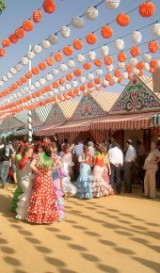 Casetas at Seville Fair
Photo: EdTarwinski
San Fermín
The festival of San Fermín is renowned for it's celebratory
tradition and is held in Pamplona anually on the 6th July. It is known
locally as Sanfermines and is held in honour of Saint Fermin. This
festival is important in terms of Spanish folklore and tradition. The
week long fiesta is most famous for it's encierro (running of the
bulls). It is belived that a million people flock to see this event
every year. The opening of the fiesta is marked by setting off the
pyrotechnic chupinazo. The rocket is launched at 12:00 noon on the 6th
of July from a city hall balcony with thousands of people celebrating
the act in the city hall square and other locations in Pamplona.
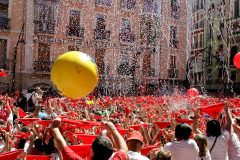 San Fermín Festival seen from
the Town Hall in Pamplona
Photo: Viajar24h
Fiestas del Pilar
Fiestas del Pilar is a large festival that takes place in Zaragoza,
Spain. This festival is religiously rooted in Spain and based on the
belief that Virgin Mary appeared to Saint James standing on a pillar.
The celebration lasts for seven days during which the city is bustling
with energy as over two million people visit the city for this fiesta.
Every day at 8 o'clock in the morning there is an event called
vaquillas, that is amateur bullfighting in the towns bullfighting ring,
or Plaza de toros. Everyone who is brave enough, can participate in this
event, in which many people get injured every year. The most important
celebration takes place on the 12th October, "The offering of flowers"
to the Virgin, who is removed from the Basilica and exhibited in a
platform placed on the square where the temple lies. The Offering of
Flowers is one of the more famous festive symbols of Spain.
 San Fermín Festival seen from
Bull running in Barcelona
Photo: BPG
Carnival
Carnival is a festive season which occurs immediately before Lent;
the main events are usually during February. Carnival typically involves
a public celebration or parade combining some elements of a circus,
mask and public street party. The Santa Cruz de Tenerifeand Las Palmas
de Gran Canaria is together with the Carnival of Cadiz, the most
important festival for Spanish tourism and Spain's largest carnival. In
Catalonia people dress up and organise parties for a week but
particularly on the weekend. Despite it being winter, parties are open
air, beginning with a cercavila to call everybody to come. Rues of
people dance along the streets. On Thursday Dijous Gras is celebrated,
also called 'the omelette day' and omelettes are eaten. Parties end by
burning Mr. Carnestoltes and with enterrament de la sardina (sardine's
funeral). Carnaval de Solsona takes place in Solsona, Lleida in central
Catalonia. It is one of the longest carnivals in Catalonia; free events
in the streets, and concerts every night, run for more than a week.
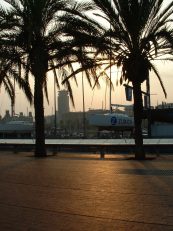 Barcelona harbour
Photo: BPG
Festival Internacional de Benicàssim
The Festival Internacional de Benicàssim is an annual music festival
sponsored by a well known beer label which takes place in the village of
Benicàssim, province of Castelló, Valencian Community in Spain. It
focuses mainly on pop, rock and electronica artists, as well as having
other elements besides music like short films, theatre, fashion and art.
Since the first festival in 1995, some of the most notable artists who
have played the festival include Paul Weller, Depeche Mode, Beck,
Radiohead, Kraftwerk, The Stone Roses, Brian Wilson, Blur, Lou Reed,
Oasis, The Chemical Brothers, Franz Ferdinand, The Killers, Morrissey,
Sigur Rós, Ride and The Strokes. As of 28 January, the line up for the
2011 Festival is as follows: Arcade Fire, Arctic Monkeys, Mumford &
Sons, Portishead, The Strokes, Beirut, Catpeople, Elbow, Friendly Fires,
Julieta Venegas, Lori Meyers, Primal Scream (present Screamadelica),
The Streets, Tinie Tempah, The Coronas, Grupo Salvaje, The Marzipan Man
Smile, Veronica Falls, Paolo Nutini, Pendulum, Mahmiri Acar. 'FIB' is
held in the seaside resort of Benicassim (Castellón province) on Costa
del Azahar, Valencia, Spain, 92.2 km away from Valencia Airport.
Festival goers who have purchased multi-day passes can camp for up to 9
days starting Monday before the festival starts and ending Tuesday after
the festival has ended. For more information please contact info@fiberfib.com
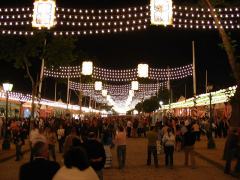
Festimad
Festimad is an alternative rock festival and cultural event held yearly
in Madrid, Spain since 1994, usually in the last week of May. Festimad
includes several parallel cultural festivals such as Performa, Graffiti,
Universimad o Cinemad, although its central event continues to be the
music festival, standing alongside the Festival Internacional de
Benicàssim as Spain's main rock concert. For more information please
contact festimad@festimad.es
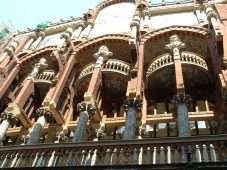 Photo: BPG
Bilbao Live Festival
The Bilbao Live Festival is a rock and pop music festival that takes
place in the summer in Bilbao, Spain since 2006. It is supported by BBK
the savings bank. Some 51,000 people attended the first edition of
Bilbao Live Festival in 2006, an event that reunited during three days
more than 40 national and international bands of rock and carps of
electronic music. Bilbao had thus burst in with force into the circuit
of great musical festivals of the summer time. The 2011 lineup includes
Coldplay, Blondie, Beady Eye, Crystal Castles, Russian Red, Ken Zazpi,
Amy Winehouse, Kasabian, Kaiser Chiefs, The Black Crowes, The Chemical
Brothers, Jack Johnson, 30 Seconds to Mars, M-Clan. For more information
please contact festivals@nme.com
|